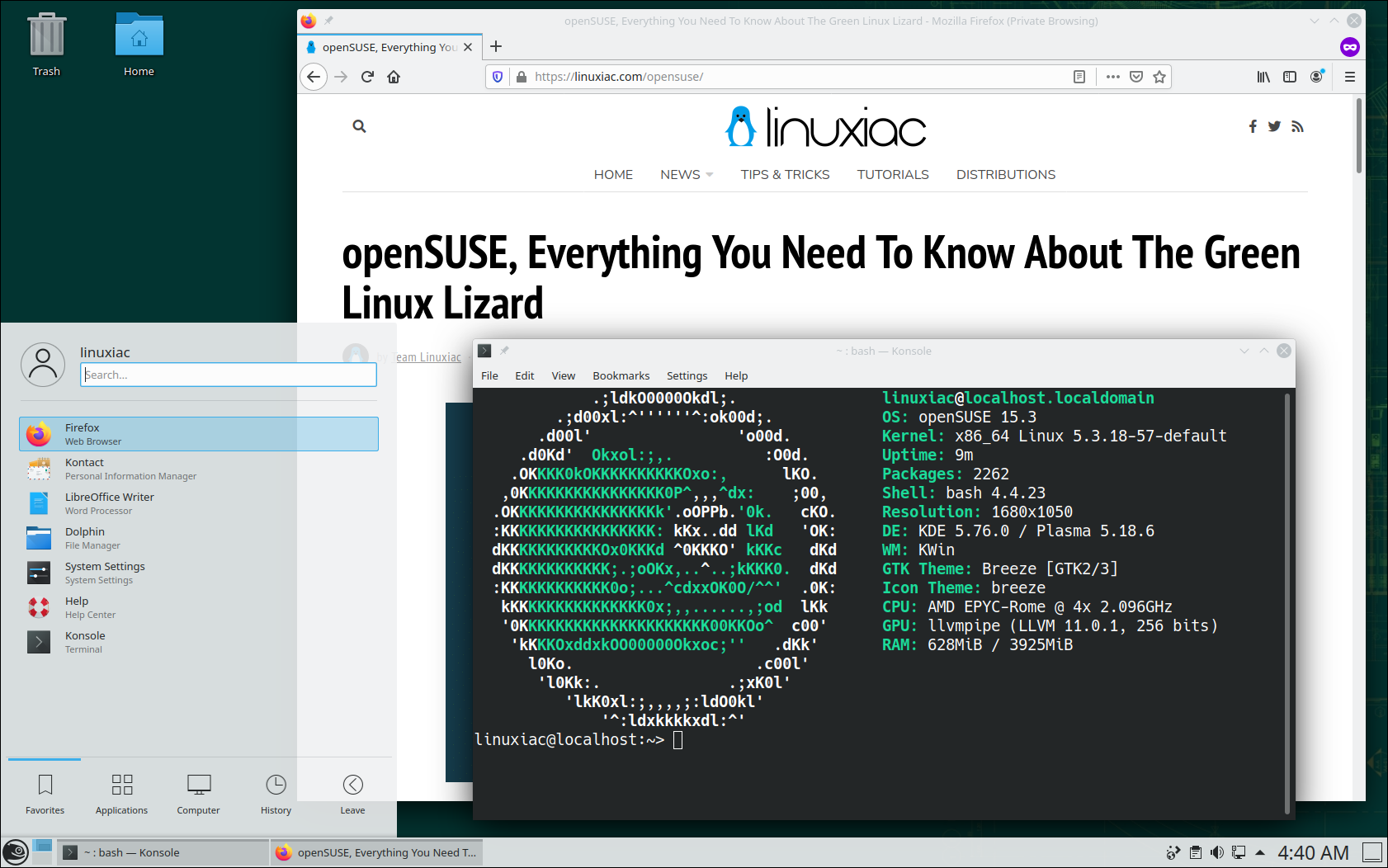OpenSUSE Leap vs. Tumbleweed: Stability or Cutting Edge?

OpenSUSE is a Linux distribution known for its stability and extensive feature set. It offers two main editions: Leap and Tumbleweed. Leap is a stable distribution that focuses on reliability and long-term support, while Tumbleweed is a rolling release that aims to provide the latest software and features.

Stability

One of the key differences between Leap and Tumbleweed is their approach to stability. Leap is designed to be a stable platform for mission-critical systems and desktop users who prioritize reliability over the latest software. It undergoes rigorous testing and follows a fixed release schedule, with updates delivered regularly to maintain stability.
Tumbleweed, on the other hand, is a rolling release distribution. This means that updates are integrated continuously as they become available. While this approach provides access to the latest software and features, it comes with a potential trade-off in stability. Because Tumbleweed is constantly being updated, there is a chance that users may encounter bugs or compatibility issues.
Software Versioning
Another notable difference is the software versioning approach. Leap provides a stable and predictable software stack. It follows a point release scheme, with new versions released every 8-12 months. This allows users to plan for updates and ensures that the system remains stable and consistent.
Tumbleweed, however, follows a rolling release model. This means that the software stack is constantly being updated, with new versions of packages available as they are released. As a result, Tumbleweed users always have access to the latest software and features but may experience more frequent updates and potential compatibility issues.
Target Audience
Leap is typically recommended for users who prioritize stability and long-term support. It is suitable for businesses, production environments, and users who prefer a reliable and consistent system.
Tumbleweed, on the other hand, is suited for users who want access to the latest software and features. It is ideal for developers, power users, and enthusiasts who are willing to tolerate the potential for occasional stability issues in exchange for cutting-edge technology.
Conclusion
The choice between OpenSUSE Leap and Tumbleweed ultimately depends on the user’s priorities. Leap offers stability and predictability, making it a reliable option for mission-critical systems and users who value stability above all else. Tumbleweed, on the other hand, provides access to the latest software and features, catering to users who prioritize cutting-edge technology and are willing to accept the potential for instability.# OpenSUSE Leap vs. Tumbleweed: Stability or Cutting Edge?
Executive Summary
OpenSUSE offers two distinct operating systems, Leap and Tumbleweed, each tailored to specific user needs. Leap prioritizes stability, aiming for a stable, reliable platform, while Tumbleweed focuses on innovation, providing cutting-edge software with rapid updates. This analysis delves into the key differences between Leap and Tumbleweed, enabling users to make informed choices based on their requirements.
Introduction
OpenSUSE, renowned for its versatility and ease of use, presents a choice between two compelling operating systems: Leap and Tumbleweed. While Leap caters to users seeking stability and reliability, Tumbleweed appeals to those eager for the latest software advancements. To guide this decision-making process, this article thoroughly examines Leap’s stability advantages and Tumbleweed’s cutting-edge offerings.
Stability vs. Innovation: The Core Distinction
The fundamental distinction between Leap and Tumbleweed lies in their contrasting approaches to package management. Leap follows a stable release schedule, with major releases occurring every 8-12 months. These releases undergo rigorous testing to ensure maximum stability and reliability, minimizing the likelihood of unexpected issues or disruptions. Tumbleweed, on the other hand, adopts a rolling release model, involving near-continuous updates and the integration of new features as they become available. This approach prioritizes innovation, offering users access to the latest software and security enhancements as they emerge.
Software Availability and Timeliness
- Leap: Emphasizing stability, Leap includes thoroughly tested and mature software packages. This conservative approach ensures a reliable and consistent platform, reducing the risk of encountering bugs or compatibility issues.
- Tumbleweed: As a rolling release distribution, Tumbleweed boasts the latest software versions as soon as they are available. This rapid access to cutting-edge applications and features is ideal for developers, enthusiasts, and users eager to experience the newest software advancements.
Support and Longevity
- Leap: OpenSUSE guarantees long-term support (LTS) for Leap releases, providing security updates, bug fixes, and critical patches for an extended period, typically ranging from 18 to 36 months. This support lifecycle offers peace of mind to users seeking dependable and well-maintained operating systems.
- Tumbleweed: Due to its rolling release nature, Tumbleweed does not offer traditional LTS support. However, it receives ongoing updates and security patches, ensuring that users always have access to the latest software versions and security enhancements.
Upgrade Considerations
- Leap: Upgrades between Leap releases are designed to be smooth and seamless, ensuring minimal disruption or data loss. The transition to newer versions typically involves a well-defined procedure that guides users through the upgrade process.
- Tumbleweed: Given its rolling release model, Tumbleweed upgrades occur automatically as new software updates are released. This continuous updating process eliminates the need for major upgrades, simplifying the maintenance and upkeep of the system.
Target Audience and Suitability
- Leap: OpenSUSE Leap is ideally suited for users prioritizing stability, reliability, and a well-tested software environment. It is the ideal choice for enterprise deployments, mission-critical applications, and users seeking a consistent and predictable operating experience.
- Tumbleweed: OpenSUSE Tumbleweed caters to users eager to experience the latest software advancements, willing to accept a higher risk of potential bugs or untested features. It is the perfect choice for developers, early adopters, and enthusiasts looking for a bleeding-edge Linux distribution.
Conclusion
OpenSUSE Leap and Tumbleweed represent distinct philosophies in operating system design, each catering to specific user needs. Leap prioritizes stability and reliability, while Tumbleweed emphasizes innovation and cutting-edge software. By carefully considering the features, support models, and target audience of each distribution, users can make an informed decision that aligns with their preferences and requirements. Whether seeking a stable and dependable platform or a gateway to the latest software advancements, OpenSUSE offers a compelling choice to meet diverse computing needs.
Keyword Phrase Tags
- OpenSUSE Leap
- OpenSUSE Tumbleweed
- Stability vs. Innovation
- Rolling Release
- Long-Term Support

Thanks for the informative comparison. I’ve been considering switching to Tumbleweed, but I’m not sure if I’m ready for the potential instability. This article has given me a lot to think about.
I’m not convinced that Tumbleweed is really more stable than Leap. I’ve heard of too many people having problems with it.
Tumbleweed is a rolling release, which means that it’s constantly being updated with the latest software. This can be great for getting the latest features and security patches, but it can also lead to instability.
I think you’re wrong about Tumbleweed being more stable than Leap. I’ve been using Tumbleweed for years and I’ve never had any problems with it.
So, Tumbleweed is more stable than Leap, but it’s also less stable? That’s like saying that a car is faster than a bike, but it’s also slower.
Oh, wow, a whole article about the stability of Tumbleweed. I’m sure this will be a riveting read.
I’m not sure what’s more unstable, Tumbleweed or my cat on a skateboard.
It’s important to remember that the stability of any operating system depends on a number of factors, including the hardware it’s running on, the software that’s installed, and the way it’s used.
I’m not sure I believe all the hype about Tumbleweed. It sounds too good to be true.
I’m so excited to try Tumbleweed! I’ve heard such great things about it.
I’m not sure what the big deal is about rolling releases. I’m happy with my Leap installation.
I’m wondering if Tumbleweed is a good choice for a laptop that I use for both work and play.
I think you’re making a mistake by choosing Tumbleweed over Leap. Leap is much more stable and reliable.
So, you’re saying that Tumbleweed is more stable than Leap, but you’re also saying that it’s less stable? That doesn’t make any sense.
Oh, wow, another article about the stability of Tumbleweed. I’m sure this will be a riveting read.